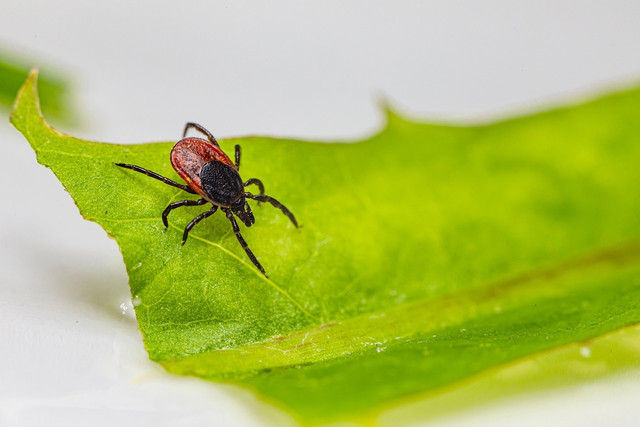
There are many tick remedies for dogs. Find out here which natural remedies you can use to protect your dog from ticks – and where ticks can be found.
Dogs love to sniff or even roll around in tall grass. As a dog owner, you often watch the spectacle with concern, as insects and especially ticks often hide there. In addition to regularly checking your dog for ticks, it is worth investing in a tick repellent. Here you can find out what different natural remedies there are to protect your dog.
Four facts about ticks in dogs that you should know
- Ticks can transmit diseases, especially Lyme disease and tick-borne encephalitis (TBE). These can be dangerous not only for you but also for your dog.
- The tick season runs approximately from February to the end of October.
- There is an increased risk of ticks in tall grass, bushes or undergrowth, as well as in forests and city parks. But ticks can also be found in your own garden.
- Ticks can be found everywhere in Germany. The risk is particularly high in the south of Germany. So-called TBE risk areas are mainly in Bavaria, Baden-Württemberg, southern Hesse and parts of Thuringia and Saxony.
Below we show you the best tick remedies for dogs.
These natural tick remedies are available for dogs

(Photo: CC0 / Pixabay / felix_w)
There are many natural ways to protect your dog from ticks.
1. Coconut oil
Coconut oil is a vegetable fat and is extracted from coconuts. Most dogs love the smell and taste of coconut oil. The lauric acid it contains acts as a deterrent to ticks. Here’s how to do it:
- Rub your dog’s fur behind the ears, on the neck and on the insides of the legs before walking.
- You can also use coconut oil as a food additive. Mix a teaspoon of coconut oil into your dog’s food every day.
- You can also offer your dog a fingertip of coconut oil as a small reward. In addition to protecting against ticks, coconut oil also nourishes your four-legged friend’s fur.
Note: The dog’s fur will look greasy in places. The effectiveness of coconut oil against ticks does not last indefinitely. Therefore, treat your dog with coconut oil every day before walking – especially if he likes to be in the water.
When buying coconut oil, make sure that it comes from controlled organic farming. Gently treated and cold-pressed coconut oil also contains the most lauric acid. High-quality coconut oil is available in organic shops and health food stores, but also in drugstores and online shops such as Avocadostore.
2. Black cumin oil
Black cumin oil is extracted from the small black seeds of the black cumin. Black cumin oil also has a deterrent effect on ticks and is a natural tick repellent for dogs. This is due to the unsaturated fatty acids it contains, such as linoleic acid, and the essential oils it contains and their smell. A few drops on the food, in the drinking water or on a treat are enough.
Note: Do not use black cumin oil on pregnant dogs or dogs with liver disease. Essential oils can cause allergies in dogs. Therefore, check with your vet beforehand whether you can use it. When buying black cumin oil, make sure that it is cold-pressed and comes from controlled organic cultivation. You can also find high-quality black cumin oil in organic shops, health food stores or online, for example at Avocadostore.
3. Amber necklace
The effectiveness of amber necklaces as a natural remedy against ticks is often discussed because it is not scientifically proven. Amber necklaces are made from raw amber – a stone made of fossil resin. There are two theories about the effectiveness of amber necklaces against ticks:
1. The friction of the chain on the dog’s fur is supposed to cause the fur to become electrostatically charged. Ticks are supposed to sense this electrical charge and avoid the dog.
2. The smell of the stones is said to deter ticks. In general, amber necklaces are said to work better on small dogs than on large ones.
Note: Amber necklaces can break when dogs play with them. The dog can injure itself or swallow parts of it.
4. Garlic
Some dog owners use garlic as a natural tick repellent. But be careful: Garlic belongs to the allium family. Garlic, onions and other alliums are toxic to dogs in high concentrations. If a dog ingests too much garlic over a long period of time, it can, in the worst case, lead to anemia.
General remark:
If in doubt, consult your veterinarian to find out which tick protection is suitable for your dog. This is especially important if you live in a tick risk area.
Tick season: What you should keep in mind when walking your dog

(Photo: CC0 / Pixabay / smellypumpy)
1. Avoid tall grass
Ticks lurk mainly in tall grass and undergrowth. Make sure that your dog does not go into tall grass when walking, especially during tick season from February to October.
2. Check your dog thoroughly for ticks after every walk
Take your time when checking your dog for ticks. This is especially true for dogs with dark fur. Pay particular attention to the ears, neck and paws. Ticks also prefer areas of the body that are less furry, such as the insides of the front and back legs. If you check your dog regularly and thoroughly, you will often catch wandering ticks that are still looking for a suitable place to bite.
What to do if your dog is bitten by a tick?

(Photo: CC0 / Pixabay / Erik_Karits)
-
After a tick bite, remove the tick as quickly as possible. If you feel unsure or the tick bites in a hard-to-reach place, you should seek veterinary help.
- Use an appropriate tool to remove the tick.
- If possible, grab the tick by its stinging apparatus, i.e. its head. Do not squeeze the tick’s abdomen and pull the tick out with a steady pull.
- Disinfect the affected area of skin.
- Take the tick to the vet if you are concerned that your dog has been infected.
- Otherwise: Dispose of the tick. To avoid any risk of infection, you can dip the tick in high-proof alcohol or disinfectant or burn it. Another option: Wrap the tick in a folded piece of paper and crush it with a heavy object.
-
What you should not do: Do not flush the tick down the toilet: Ticks are extremely resilient and can survive in water for long periods of time. Do not crush the tick with your fingers. Avoid contact with the tick’s body fluids.
Read more on Utopia:
- Dog-friendly garden: Pay attention to these 7 things
- Adopting a dog: tips and reputable contact points
- Dog eats grass: Is it harmful?
English version available: Natural Tick Repellent for Dogs: Protecting Your Pet from Tick Bites
Edited by Lena Kirchner
** marked with ** or orange underlined Links to sources are partly affiliate links: If you buy here, you are actively supporting Techzle\.com, because we then receive a small part of the sales proceeds. .